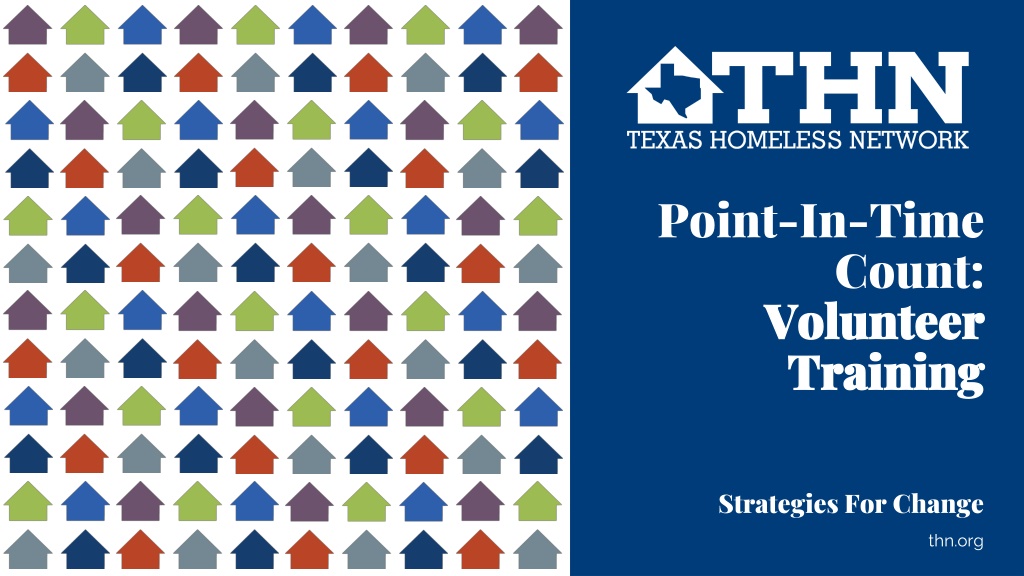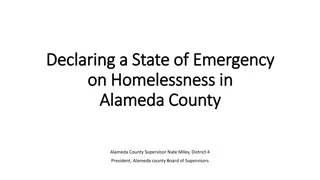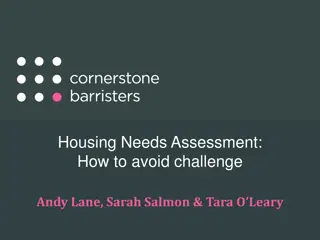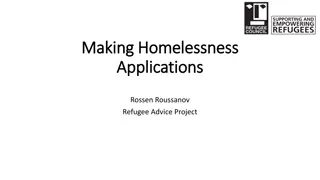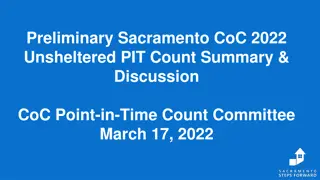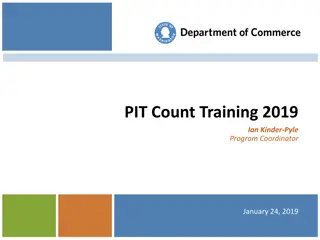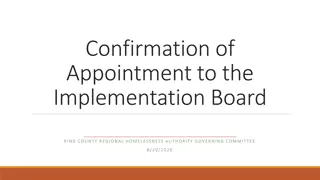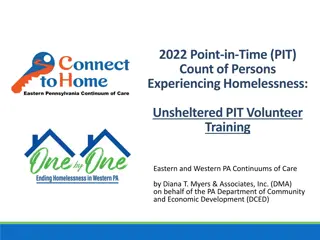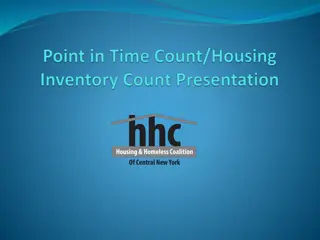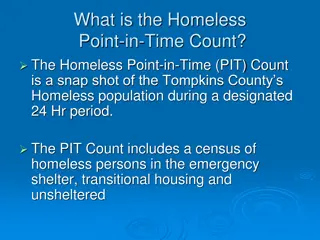Point-In-Time Count Strategies for Homelessness Assistance
Snapshot of homeless individuals in a community on a single day to plan services, measure progress, and identify needs, strengths, and gaps. Process involves selecting a PIT lead, forming a committee, training volunteers, and counting individuals in various settings. Differentiates between who to count (emergency shelters, transitional housing) and who not to count (doubled-up situations, supportive housing). Unsheltered PIT surveys identify homeless individuals in places not intended for habitation like streets, vehicles, or tents.
Download Presentation

Please find below an Image/Link to download the presentation.
The content on the website is provided AS IS for your information and personal use only. It may not be sold, licensed, or shared on other websites without obtaining consent from the author. Download presentation by click this link. If you encounter any issues during the download, it is possible that the publisher has removed the file from their server.
E N D
Presentation Transcript
Point-In-Time Count: Volunteer Volunteer Training Training Strategies For Change thn.org
Agenda PIT Overview PIT Methodology Unsheltered PIT Count Sheltered PIT Count Volunteer Prep Counting Us App Q&A
PIT Date January 23rd, 2020
What is a Point-In-Time Count (PIT)? A snapshot of how many homeless individuals are in your community on a single day. On the local level, point-in-time counts help communities plan services and programs to appropriately address local needs, measure progress in decreasing homelessness, and identify strengths and gaps in a community s current homelessness assistance system.
PIT Background Why we count FUNDING Eligibility to apply for/ receive CoC funds from HUD EXTENT Trends of homelessness in the local area Characteristics of those experiencing homelessness New programs AWARENESS Raise community awareness Raise political awareness
SUCCESSFUL PIT COUNT Select PIT Lead and Backup Form PIT Committee Meet to Plan the Count Inform Community Locations, Locations, Locations Train Recruit Volunteers Know the Survey/app Volunteers Organize donations Gather to Count!
WHO TO COUNT Emergency Shelter Transitional Housing Domestic Violence Shelter Hotel/Motel paid for by an organization Places not meant for human habitation Individuals & Families Living In:
WHO NOT TO COUNT Doubled-up situations Substandard housing Permanent Supportive Housing program Rapid Re-housing program Hotel/Motel paid for with own funds Locations using HUD-VASH vouchers Shelters designed for foster care or DFPS children Individuals & Families Living In:
Unsheltered PIT Count The unsheltered PIT survey requires volunteers to identify homeless people that are living in places not meant for human habitation, such as: On the street In abandoned buildings In their vehicles In tents/shanties Public parks In the woods Transportation stations
Unsheltered PIT Survey Steps There are five steps to completing an unsheltered PIT count survey. As an unsheltered volunteer you should: 1. Identify yourself, engage potential participants and explain the purpose of the count. 2. Deliver the script and the consent process. Obtain verbal consent to proceed. 3. Ask the screening questions. Determine if the individual is eligible. Has anyone asked you questions about experiencing homelessness? Where are you sleeping tonight? 4. If eligible, administer the survey questions, recording the participant s responses. If ineligible, thank them for their time and move on. 5. Thank the respondent for their participation. If possible, provide the participant with donated items.
Unsheltered PIT Sample Script Hello, my name is ___________________, and I am helping ________________conduct a short survey of our community. We would like to learn more about people experiencing homelessness, what kinds of problems they face, and to see what services are needed to address homelessness. Your participation is strictly voluntary, and all of your responses are confidential. Your privacy will be protected and respected. If questions make you uncomfortable you do not have to answer them. Would you be willing to take a few minutes to answer some questions?
Sheltered PIT Count HUD defines sheltered homeless persons as adults, children, and unaccompanied youths who, on the night of the count, are living in shelters for the homeless. Regardless of funding source, all providers of shelter, vouchers, or funds for shelters (including motel/hotel rooms), and/or transitional housing need to provide unduplicated information about the individuals and families on January 23rd, 2020. For Emergency Shelters, you should conduct the surveys in the late afternoon/evening when participants are checking in to stay the night.
Sheltered PIT Who do you count? You should count: Emergency Shelters Domestic violence shelters Hotel, motel, or apartment vouchers paid for by a public or private agency because the individual or family is homeless Transitional Housing You should NOT count: Persons living doubled up in conventional housing; Formerly homeless persons living in Section 8 SRO, Shelter Plus Care, Supportive Housing Program permanent housing or other permanent housing units; Persons living in conventional housing and receiving temporary assistance (Rapid Rehousing or Homelessness Prevention) from a program funded by the Homelessness Prevention and Rapid Re-housing Program (HPRP); Children or youth, who because of their own or a parent s homelessness or abandonment now reside temporarily or for a short anticipated duration in hospitals, residential treatment facilities, emergency foster care, or detention facilities; Adults in mental health facilities, chemical dependency facilities, or criminal justice facilities.
Unsheltered And Sheltered Counts Do s If you have obtained consent Don ts Do not complete a survey without consent Do not continue the survey if the individual has expressed the desire to end the survey Do not complete a survey based on an intake form unless you have specifically obtained consent to do so.
Observation PIT Count This survey requires NO direct interaction and is used mostly as a head count Reasons why you would conduct an Observation survey: The individual is sleeping Refused to take the survey If you do not feel comfortable approaching the participant
Observation Survey Don ts Do not fill out an observation survey if you have not laid eyes on the individual that day Do s Someone is sleeping You do not feel comfortable going to a certain area A person did not give their consent to participate in the survey or they don t want to complete the survey in it s entirety Someone does not seem to understand the consent process and cannot reasonably consent to the survey.
PIT Volunteer Prep and Forms Download and register an account with the Counting Us App Practice entering surveys using code: TX2020 Don t be afraid to make mistakes, this is all test data! Review the survey and become comfortable with the questions Talk to your PIT lead about any concerns prior or on the day of the count
Safety Do Always work in teams Be respectful of space Ask a person to participate if you think they are homeless Introduce yourself and explain what you are doing Be sincere and caring Know how to de-escalate Know emergency numbers Honor requests to not participate Provide shelter information if possible Dress appropriately Leave valuables behind Don t Wake up someone Approach if you don t feel comfortable Mandate participation Invade personal space Promise anything you can t deliver Be judgmental Give money or offer rides Share any confidential info or photos of participants Panic Put anyone in danger Deviate from the survey
Best Practices Familiarize yourself with the survey Communicate your intentions to prospective survey participants Obtain consent to administer the survey Express confidence and compassion When surveying individuals in a group, prioritize safety and protect participant s information Come up with a safety phrase for discomfort amongst your team Know volunteer expectations Know community resources Contact PIT Lead if any issues arise
Checklist Items to bring with you: Comfortable clothes and shoes Fully charged cell phone (portable charger if possible) Flashlight (if conducting count at night or early morning) Pen and notepad Vehicle if necessary Goodie bags to pass out if provided
Volunteer Hour Tracker ALL VOLUNTEERS MUST FILL OUT ONLINE FORM! *Please have volunteers fill out on the day of the count after completing their shift*
Counting Us App Counting Us App
What you need Prep and Forms Download and register an account with the Counting Us App Practice entering surveys using code: TX2020 Don t be afraid to make mistakes, it is all test data before 1/23/20! Make sure you have a full battery! Review the survey and become comfortable with asking the questions Volunteer Interviewing Guide Talk to your PIT lead about any concerns prior or on the day of the count It is important, especially on the day of the count, to inform your PIT lead of any issues immediately
Day of Count Set-Up Key MAKE SURE ON THE DAY OF THE COUNT ALL SURVEYS ARE COLLECTED UNDER SET-UP KEY TX2020
Counting Us Training Materials Click here for a short tutorial on Registering for the Count Click here for a short tutorial on Sheltered Count Click here for a short tutorial on Unsheltered Count Click here for a short tutorial on Observation Count *Links to these videos are also on our website thn.org
DV Survivors and Surveys Use Counting Us App On geo-location screen, click Enter Address button and ONLY enter in City and State information DO NOT enter in first or last name For date of birth information ONLY enter in age range
Register for the Count Click here Go online to THN s website Texas Balance of State Data Point-in-Time Reports Winter Training Materials Volunteer Materials Volunteer Registration Portal Complete registration ASAP!
Next Steps! 1. Register for the Count 2. Complete the PIT Quiz on Google Forms (link on next slide) 3. Work with your PIT Lead to develop a strategy and game plan for where you will count on 1/23/20. 4. Check out the Volunteer Materials on THN s website
DONT FORGET! Please submit the Volunteer Hour Tracker form online by 1/30/20
Quiz time! Please click here to start the process Steps to complete: 1. Complete the quiz (need 70% or higher to pass) If you do not pass the first time, no worries, please take it over 2. SUBMIT!
THANK YOU!!! THANK YOU!!!
